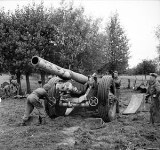
BL 7.2 inch Howitzer Mk.I
Encyclopedia
The BL 7.2 inch Howitzer Mk.I and subsequent marks were a series of heavy artillery pieces designed by the United Kingdom
at the start of World War II
. The 7.2 inch (183 mm) was not a new design, but instead a re-lined version of the 8 inch (203 mm) howitzers dating from World War I
. The carriage was a modernized version of that used on both the 8 inch howitzer and World War I, 6 inch gun. The weapons were a stop-gap measure to meet the urgent need for heavy artillery faced by the Allies
early in World War II.
However, they managed to perform relatively well, and were kept in service by the British until the end of the war, in their AGRA Units
as parts of "Heavy" regiments to provide heavy fire support for British and Commonwealth troops. In action, each gun would be served by a crew of 10 men except for the Mark 6 versions, which required 12.
Mk 1*
Mk 2
Mk 3
Mk 4
Mk 5
Mk 6
 Canada
Canada
United Kingdom
The United Kingdom of Great Britain and Northern IrelandIn the United Kingdom and Dependencies, other languages have been officially recognised as legitimate autochthonous languages under the European Charter for Regional or Minority Languages...
at the start of World War II
World War II
World War II, or the Second World War , was a global conflict lasting from 1939 to 1945, involving most of the world's nations—including all of the great powers—eventually forming two opposing military alliances: the Allies and the Axis...
. The 7.2 inch (183 mm) was not a new design, but instead a re-lined version of the 8 inch (203 mm) howitzers dating from World War I
World War I
World War I , which was predominantly called the World War or the Great War from its occurrence until 1939, and the First World War or World War I thereafter, was a major war centred in Europe that began on 28 July 1914 and lasted until 11 November 1918...
. The carriage was a modernized version of that used on both the 8 inch howitzer and World War I, 6 inch gun. The weapons were a stop-gap measure to meet the urgent need for heavy artillery faced by the Allies
Allies of World War II
The Allies of World War II were the countries that opposed the Axis powers during the Second World War . Former Axis states contributing to the Allied victory are not considered Allied states...
early in World War II.
However, they managed to perform relatively well, and were kept in service by the British until the end of the war, in their AGRA Units
Army Group Royal Artillery
An Army Group Royal Artillery was a British Commonwealth military formation type during the Second World War and shortly thereafter, generally assigned to corps. An AGRA was mainly composed of medium artillery regiments but heavy regiments and field regiments were also used...
as parts of "Heavy" regiments to provide heavy fire support for British and Commonwealth troops. In action, each gun would be served by a crew of 10 men except for the Mark 6 versions, which required 12.
Marks
Mk 1Mk 1*
Mk 2
Mk 3
Mk 4
Mk 5
- Mounted on a modified US 155 mm Long Tom155 mm Long TomThe 155 mm Gun M1 and M2 , widely known as Long Tom, were 155 millimeter calibre field guns used by the United States armed forces during World War II and Korean War. The Long Tom replaced the Canon de 155 mm GPF in United States service.-Development:Before entering World War I, the United...
carriage. Not introduced into service
Mk 6
- Used a US 155 mm Long Tom carriage and a lengthened barrel; introduced into service in 1945. Retained until the early 1960s.
Operators
See: "7.2-Inch Howitzer". British Artillery in World War 2. Canada
Canada
- 57 (later 166) (Newfoundland) Field Artillery Regiment.
- 59 Heavy Regiment
- Royal ArtilleryRoyal ArtilleryThe Royal Regiment of Artillery, commonly referred to as the Royal Artillery , is the artillery arm of the British Army. Despite its name, it comprises a number of regiments.-History:...
- 1 Heavy Regiment
- 32 Heavy Regiment
- 51 (Lowland) Heavy Regiment
- 52 (Bedfordshire YeomanryBedfordshire YeomanryBedfordshire Yeomanry, a unit of the British Army originally raised in 1797 as a body of independent troops, the Bedfordshire Yeomanry Cavalry was disbanded after the Napoleonic Wars and briefly reformed from 1817 to 1827....
) Heavy Regiment - 53 Heavy Regiment
- 54 Heavy Regiment
- 55 Heavy Regiment
- 56 Heavy Regiment
- 58 Heavy Regiment
- 60 Heavy Regiment
- 61 Heavy Regiment
- 75 Heavy Regiment
- 171 Heavy Regiment

